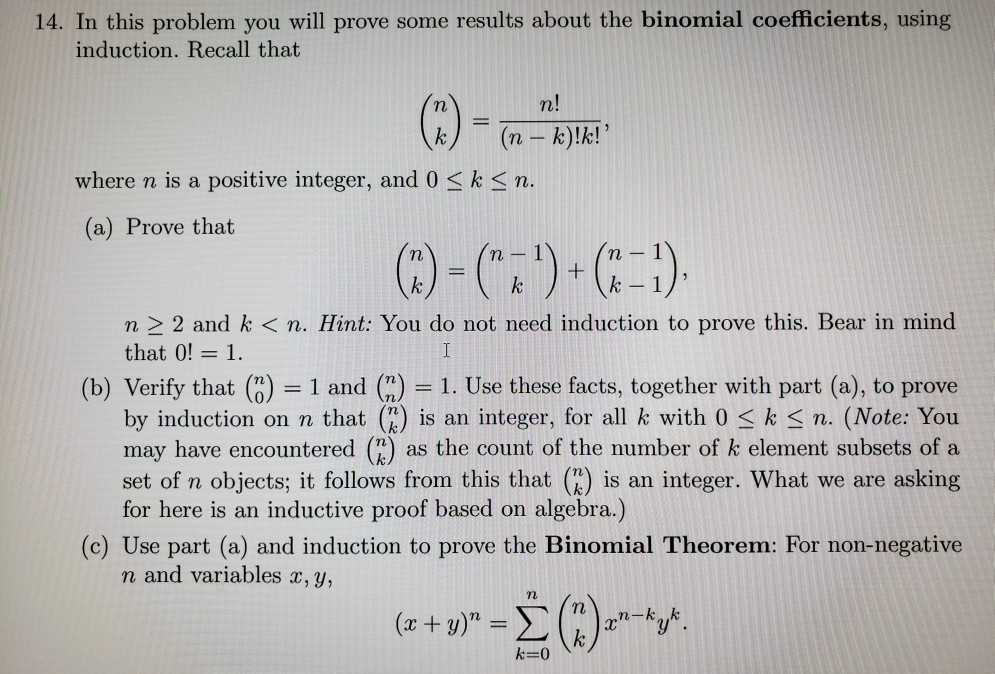(a) Prove that n n | k k k-1 | n > 2 and k < n. Hint: You do not need induction to prove this. Bear in mind that 0! = 1. I %3D (b) Verify that (") = 1 and (") by induction on n that () is an integer, for all k with 0 < k < n. (Note: You may have encountered (") as the count of the number of k element subsets of a set of n objects; it follows from this that (E) is an integer. What we are asking for here is an inductive proof based on algebra.) = 1. Use these facts, together with part (a), to prove %3D (c) Use part (a) and induction to prove the Binomial Theorem: For non-negative n and variables x, y, (2 + u)" = E (;)-*y*. %3D k k=0
(a) Prove that n n | k k k-1 | n > 2 and k < n. Hint: You do not need induction to prove this. Bear in mind that 0! = 1. I %3D (b) Verify that (") = 1 and (") by induction on n that () is an integer, for all k with 0 < k < n. (Note: You may have encountered (") as the count of the number of k element subsets of a set of n objects; it follows from this that (E) is an integer. What we are asking for here is an inductive proof based on algebra.) = 1. Use these facts, together with part (a), to prove %3D (c) Use part (a) and induction to prove the Binomial Theorem: For non-negative n and variables x, y, (2 + u)" = E (;)-*y*. %3D k k=0
Elements Of Modern Algebra
8th Edition
ISBN:9781285463230
Author:Gilbert, Linda, Jimmie
Publisher:Gilbert, Linda, Jimmie
Chapter2: The Integers
Section2.2: Mathematical Induction
Problem 23E: Let and be integers, and let and be positive integers. Use mathematical induction to prove the...
Related questions
Topic Video
Question

Transcribed Image Text:(a) Prove that
n
n
|
k
k
k-1
|
n > 2 and k < n. Hint: You do not need induction to prove this. Bear in mind
that 0! = 1.
I
%3D
(b) Verify that (") = 1 and (")
by induction on n that () is an integer, for all k with 0 < k < n. (Note: You
may have encountered (") as the count of the number of k element subsets of a
set of n objects; it follows from this that (E) is an integer. What we are asking
for here is an inductive proof based on algebra.)
= 1. Use these facts, together with part (a), to prove
%3D
(c) Use part (a) and induction to prove the Binomial Theorem: For non-negative
n and variables x, y,
(2 + u)" = E (;)-*y*.
%3D
k
k=0
Expert Solution
This question has been solved!
Explore an expertly crafted, step-by-step solution for a thorough understanding of key concepts.
This is a popular solution!
Trending now
This is a popular solution!
Step by step
Solved in 3 steps with 3 images

Knowledge Booster
Learn more about
Need a deep-dive on the concept behind this application? Look no further. Learn more about this topic, advanced-math and related others by exploring similar questions and additional content below.Recommended textbooks for you

Elements Of Modern Algebra
Algebra
ISBN:
9781285463230
Author:
Gilbert, Linda, Jimmie
Publisher:
Cengage Learning,


Linear Algebra: A Modern Introduction
Algebra
ISBN:
9781285463247
Author:
David Poole
Publisher:
Cengage Learning

Elements Of Modern Algebra
Algebra
ISBN:
9781285463230
Author:
Gilbert, Linda, Jimmie
Publisher:
Cengage Learning,


Linear Algebra: A Modern Introduction
Algebra
ISBN:
9781285463247
Author:
David Poole
Publisher:
Cengage Learning

Algebra and Trigonometry (MindTap Course List)
Algebra
ISBN:
9781305071742
Author:
James Stewart, Lothar Redlin, Saleem Watson
Publisher:
Cengage Learning

College Algebra
Algebra
ISBN:
9781305115545
Author:
James Stewart, Lothar Redlin, Saleem Watson
Publisher:
Cengage Learning

College Algebra (MindTap Course List)
Algebra
ISBN:
9781305652231
Author:
R. David Gustafson, Jeff Hughes
Publisher:
Cengage Learning